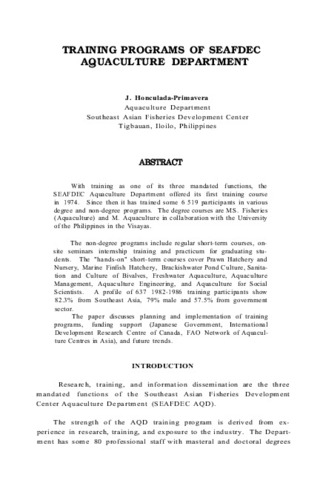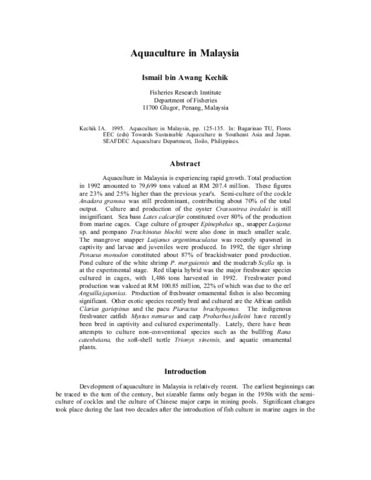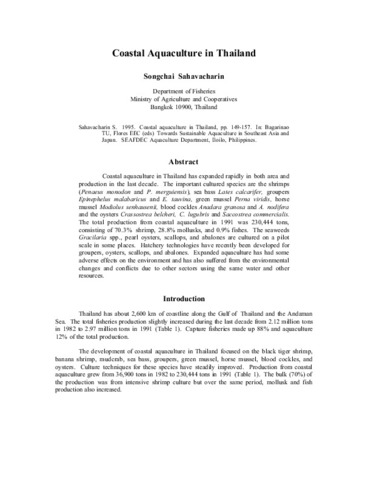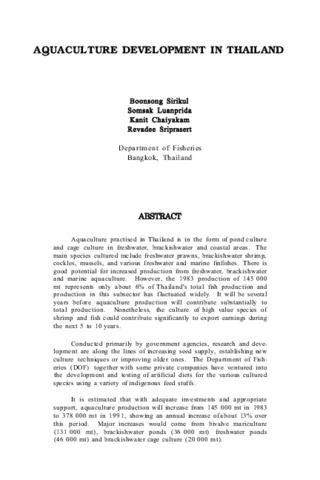Training programs of SEAFDEC Aquaculture Department
Share
trừu tượng
With training as one of its three mandated functions, the SEAFDEC Aquaculture Department offered its first training course in 1974. Since then it has trained some 6 519 participants in various degree and non-degree programs. The degree courses are MS. Fisheries (Aquaculture) and M. Aquaculture in collaboration with the University of the Philippines in the Visayas.
The non-degree programs include regular short-term courses, onsite seminars internship training and practicum for graduating students. The "hands-on" short-term courses cover Prawn Hatchery and Nursery, Marine Finfish Hatchery, Brackishwater Pond Culture, Sanitation and Culture of Bivalves, Freshwater Aquaculture, Aquaculture Management, Aquaculture Engineering, and Aquaculture for Social Scientists. A profile of 637 1982-1986 training participants show 82.3% from Southeast Asia, 79% male and 57.5% from government sector.
The paper discusses planning and implementation of training programs, funding support (Japanese Government, International Development Research Centre of Canada, FAO Network of Aquaculture Centres in Asia), and future trends.
Suggested Citation
Honculada-Primavera, J. (1988). Training programs of SEAFDEC Aquaculture Department. In J. V. Juario & L. V. Benitez (Eds.), Perspectives in Aquaculture Development in Southeast Asia and Japan: Contributions of the SEAFDEC Aquaculture Department. Proceedings of the Seminar on Aquaculture Development in Southeast Asia, 8-12 September 1987, Iloilo City, Philippines. (pp. 293-301). Tigbauan, Iloilo, Philippines: SEAFDEC, Aquaculture Department.
Chủ thể
Bộ sưu tập
- ADSEA '87 [20]
Related items
Showing items related by title, author, creator and subject.
-
Aquaculture in Malaysia
Kechik, Ismail bin Awang. (Aquaculture Department, Southeast Asian Fisheries Development Center, 1995)Aquaculture in Malaysia is experiencing rapid growth. Total production in 1992 amounted to 79,699 tons valued at RM 207.4 million. These figures are 23% and 25% higher than the previous year's. Semi-culture of the cockle ... -
Coastal aquaculture in Thailand
Sahavacharin, Songchai (Aquaculture Department, Southeast Asian Fisheries Development Center, 1995)Coastal aquaculture in Thailand has expanded rapidly in both area and production in the last decade. The important cultured species are the shrimps (Penaeus monodon and P. merguiensis), sea bass Lates calcarifer, groupers ... -
Aquaculture development in Thailand
Sirikul, Boonsong; Luanprida, Somsak; Chaiyakam, Kanit; Sriprasert, Revadee (Aquaculture Department, Southeast Asian Fisheries Development Center, 1988)Aquaculture practised in Thailand is in the form of pond culture and cage culture in freshwater, brackishwater and coastal areas. The main species cultured include freshwater prawns, brackishwater shrimp, cockles, mussels, ...





